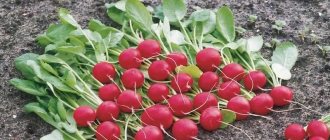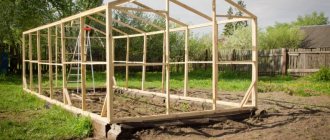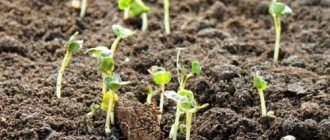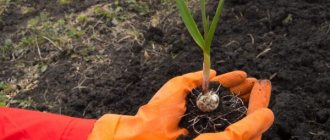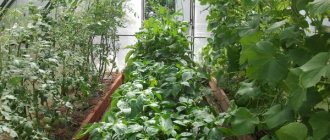Pre-winter sowing is the best autumn “investment” in the garden. Already in early spring, in the beds in the greenhouse you will see the first parsley, dill, tender lettuce leaves, juicy radishes and green, fragrant onions. There is also great news for flower lovers: having planted seeds before winter, with the onset of warm spring days, you will be able to watch the flowering of a colorful carpet of marigolds, zinnias and snapdragons. How to achieve this? It's not that difficult. You will find everything you need to know about winter sowing of vegetables and flowers in a greenhouse in this video.
Pre-winter sowing of vegetables, herbs and flowers in a greenhouse
When is the best time to start winter sowing?
The optimal period for planting seeds before winter in a greenhouse is late October-early November. By this time, as a rule, stable frosts have already set in, but the soil has not yet completely frozen. An unheated greenhouse is suitable for these purposes; the material is polycarbonate or glass. By following the rules for planting seeds in the fall and properly caring for the seedlings in the spring, you can get an early spring harvest without any problems.
Read our detailed article: What to plant before winter? 20+ crops for winter sowing
Advantages of winter planting
The main advantage of planting seeds before winter is the opportunity to achieve earlier vegetation of vegetable crops, herbs, and root crops. Due to this, the harvest can be harvested 2-3 weeks earlier than usual.
There are other advantages, for example, natural stratification. In order to encourage seeds to germinate, they are often subjected to stratification. The process involves keeping the seeds at low temperatures, so that the plants are hardened during the initial growth stage. The seedlings grow strong and are not so afraid of sudden temperature changes, diseases and pests. Seeds planted in a greenhouse before winter undergo natural stratification. Therefore, the yield with such sowing is usually higher than with classical planting.
Important! Since there is a risk of seedlings, the seeds need to be planted more densely than usual. For winter sowing, the volume of seeds for planting should be increased by 25-50%.
Disadvantages of planting seeds before winter
But, as usual, there was a “fly in the ointment”. The main disadvantages of winter sowing include the risk of seedlings freezing. In a greenhouse, plants can suffer greatly due to the vagaries of the weather. For example, if warming lasts for a long time, which then abruptly gives way to cooling, then the young shoots that appear will die completely or partially.
Advice! The death of seedlings is easy to prevent. Just cover the beds with any covering material. If your greenhouse has heat, turn it on to maintain the optimal temperature.
What should a winter greenhouse be like?
For year-round use, you need an insulated permanent greenhouse, which is located on a small hill or located on a flat area. The building must be protected from northern winds, for which the wall on the windy side can be:
- make deaf;
- equip with an insulated vestibule.
A good option would be an extension to a utility building or residential premises. A winter greenhouse must be installed on a foundation buried 0.8 m. Such a building must be protected from flooding by precipitation, melt and groundwater. In winter, the heating system must operate without failure, since the slightest deviation in microclimate conditions will cause the death of plants.
In addition, the greenhouse must be equipped with an irrigation system, ideally a drip irrigation system (to save water), as well as a ventilation system. If in summer and spring plants can carry out the process of photosynthesis without additional lighting, then in winter this will be impossible. In this regard, you need to take care of organizing additional lighting.
The best option is infrared lamps. The greenhouse must be equipped with thermometers in order to be able to control the temperature. Even in the most severe frost, the minimum permissible value is +15°C. Optimally, the room temperature should be maintained within +20…+23°C.
Learn more about greenhouse lighting.
Planting seeds before winter in a greenhouse: step-by-step instructions
The bed preparation is carried out as usual. You will need the most common gardening tools - a shovel and a rake. It is also necessary to stock up on organic or mineral fertilizers in advance. Prepare the bed as follows: Dig up the soil.
The bed preparation is carried out as usual
When digging, apply organic or mineral fertilizers. Level the soil surface with a rake and break up large clods of earth. Remove any remaining stems, roots and weeds, if any. Further, the order of work will be different for different cultures. Let's look at each of them in more detail.
Salad crops. Do you want to get a lot of fresh and juicy salad greens at the very beginning of spring? Then it’s a small matter - plant the seeds of salad crops before winter in the fall. To do this, make furrows 2-4 cm deep. Maintain a distance of 5-10 cm between rows. There is no need to water the furrows. Seeds are planted dry, without prior soaking.
Planting salad crops
Root vegetables Radishes, early carrots and beets are planted differently. The furrows are made at a large distance from each other - about 10-15 cm. Their depth should be approximately 3-4 cm. The seeds in the row are laid out in 1 cm increments. There is no need to soak the seeds before planting. For planting, choose early ripening varieties and hybrids. They must have time to ripen before the seedlings are planted in the greenhouse in the spring. You can also sow root crops around the perimeter of the bed, closer to its outer edge. This will free up the bulk of the soil in case the carrots or radishes are not ripe by the time the seedlings are transplanted.
Planting root vegetables
Important point! After planting the seeds, fill the furrows with soil. Be sure to compact the soil. This increases the adhesion of the seed surface to the soil and improves their germination. Then mulch the planting bed. You can use needle case, straw, hay, sawdust as mulch.
Onion sets. Any variety of onion set is suitable for pre-winter planting. There is no need to select any special winter variety for “forcing” greens. Only if there is a desire to get an onion not for a feather, but specifically for a turnip, then in this case non-shooting winter varieties are selected. Plant the seedlings in furrows along the edge of the bed. There is no need to soak the bulbs before planting. Place them in the furrows not too sparingly. After all, our task is to grow onions for greens, not for turnips. Cover the planted bulbs with soil. Lightly mulch them on top with a thin layer of peat or humus.
Planting onion sets
Black onion. You can also plant onion seeds – nigella – before winter. In the spring, they will also grow into wonderful salad greens. Chives, batun - these and other varieties of onions can be planted before winter to obtain a harvest in early spring. Nigella is sown densely in shallow furrows, since unfavorable weather conditions can also cause seedlings to fall out.
Onion "nigella"
Flowers. Many flower crops can also be “sent” before winter. Zinnias, asters, snapdragons, marigolds and other annuals tolerate winter sowing well. The best results are shown by autumn sowing of lavender. After all, in order for lavender seeds to sprout together, they must undergo stratification. As already mentioned, in unheated greenhouses this process occurs naturally.
Planting flowers
Note! There is one drawback to planting flowers in a greenhouse before winter. As a rule, they do not have enough time to fully develop by the time the seedlings are planted in the greenhouse. For this reason, it is better to plant seeds in separate containers. Drainage holes should be made at the bottom of the pots. Excess moisture will escape through them, which will help avoid rotting of the roots.
Read our detailed article: 20+ flowers that can be sown before winter
Some advice from experts
So, if you have a brilliant plan for selling greens in winter, then do not think that all this will bring you millions.
Here are some important points:
- Greens can be grown at home without spending additional money on arranging and heating a greenhouse. Therefore, you will not be able to create competition in the market while making a decent profit. Do not build castles in the air if you are not prepared to spend money and sometimes suffer significant losses.
- There is no point in building a heated greenhouse solely for growing greens. The costs will be colossal, but the profits can be meager. The best option is to grow any crop in a greenhouse, where you can place shelves with herbs in parallel. Parsley, dill and onions do not need deep and fertile soil at all, as tomatoes or cucumbers do.
- Fertilizers and biostimulants are needed much more in winter than in summer. Lack of light, heat and infrequent watering leads any greenery to stress, which in turn slows down the growing season.
- Planting material is extremely important. If you are thinking of saving on seeds, then you may not even dream of a good harvest. You will definitely have to spend money on high-quality planting material.
- It is worth abandoning the idea of growing greens in a greenhouse in winter if the climate is harsh. Agree, when it’s -30℃ outside, heating even the smallest room can be extremely difficult. Heating costs will not pay off. But it makes sense to grow crops in a greenhouse when in winter the temperature does not drop below -10℃, and the number of truly frosty days can be counted on one hand.
If you want to get good harvests of greens in winter, then all these factors will have to be taken into account. Plus, don’t forget about such an important point as sales. Growing greens is one thing, but finding who needs it is not so easy.
If you want to grow greenfinch purely for yourself, then there is no need for a greenhouse. Place folding racks, take some soil in containers, arrange special lamps and good luck. Our article will most likely be useful for those who want to grow greens for sale, having at their disposal a heated greenhouse.
Planting flowers before winter is carried out as follows:
- Fill separate containers with nutritious soil from the garden bed. You can also use any universal peat soil.
- Plant the seeds in pots. Don't plant them too deep. It is enough to bury them in the ground a couple of centimeters.
- Bury containers with plantings into greenhouses flush with the ground. This will help protect the seeds from low temperatures in winter. In spring it will be very easy to get containers with flowers. Simply remove the tray from the ground.
After sowing seeds before winter, there is no need to water the soil or throw snow on the beds. Watering can trigger the seeds to begin sprouting. Then, when frost sets in, they will freeze and die. But, starting from mid-late winter, snow, on the contrary, needs to be brought into the greenhouse and spread on the beds. The snow will melt, saturate the soil with moisture and awaken the seeds. In beds with planted shifts, you can also install arcs over which you can throw covering material. Under it, the soil will warm up better and the seeds will sprout faster. This means that the spring harvest will definitely be early.
Radish
Radishes are characterized by cold resistance, unpretentiousness, and early emergence of seedlings. The following varieties are suitable for spring cultivation in a greenhouse:
- "Mokhovsky";
- "Camelot";
- "Ruby";
- "Heat";
- "Dawn".
The listed varieties produce a harvest 40 days after germination. Granulated seeds can be planted without preparation. To begin with, ordinary seed is soaked in a weak solution of potassium permanganate. You can let the seeds hatch so that seedlings appear faster. Sowing in the greenhouse is carried out when daytime temperatures reach 19 °C, and night temperatures reach 8–9 °C. Usually early planting is carried out in April.
Radishes love loose soil with a neutral reaction. The beds are prepared 2 weeks before sowing. The soil is first enriched by pouring a solution of nitroammophoska (1 tsp per bucket of water). To warm the soil a week before sowing, you need to cover it with film.
The furrows are cut at intervals of 15 cm. A distance of 5 cm should be maintained between changes. Thinning is not recommended for this crop, since radishes have sensitive roots. The crops are sprinkled with earth and lightly compacted. It is advisable to cover the radishes with film at night. The appearance of seedlings does not take long - only 3-4 days. Plantings require regular watering; moisture should penetrate to a depth of 15 cm.
